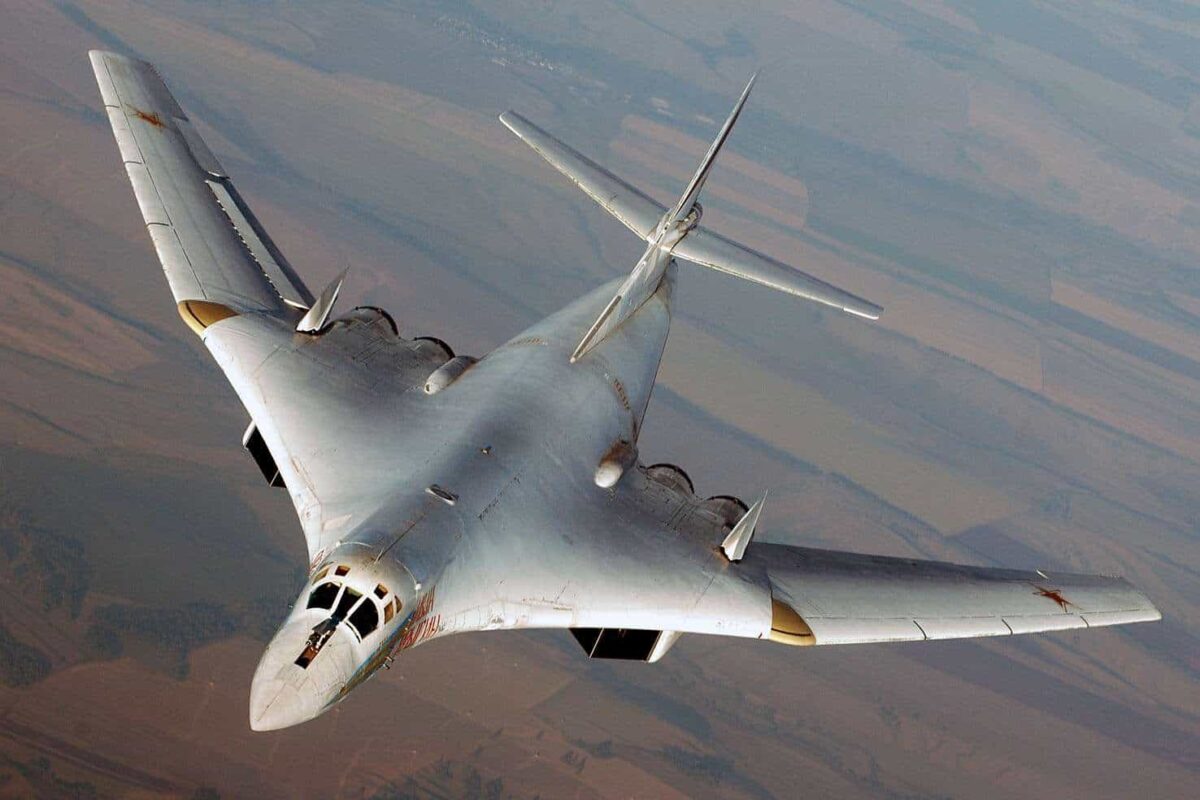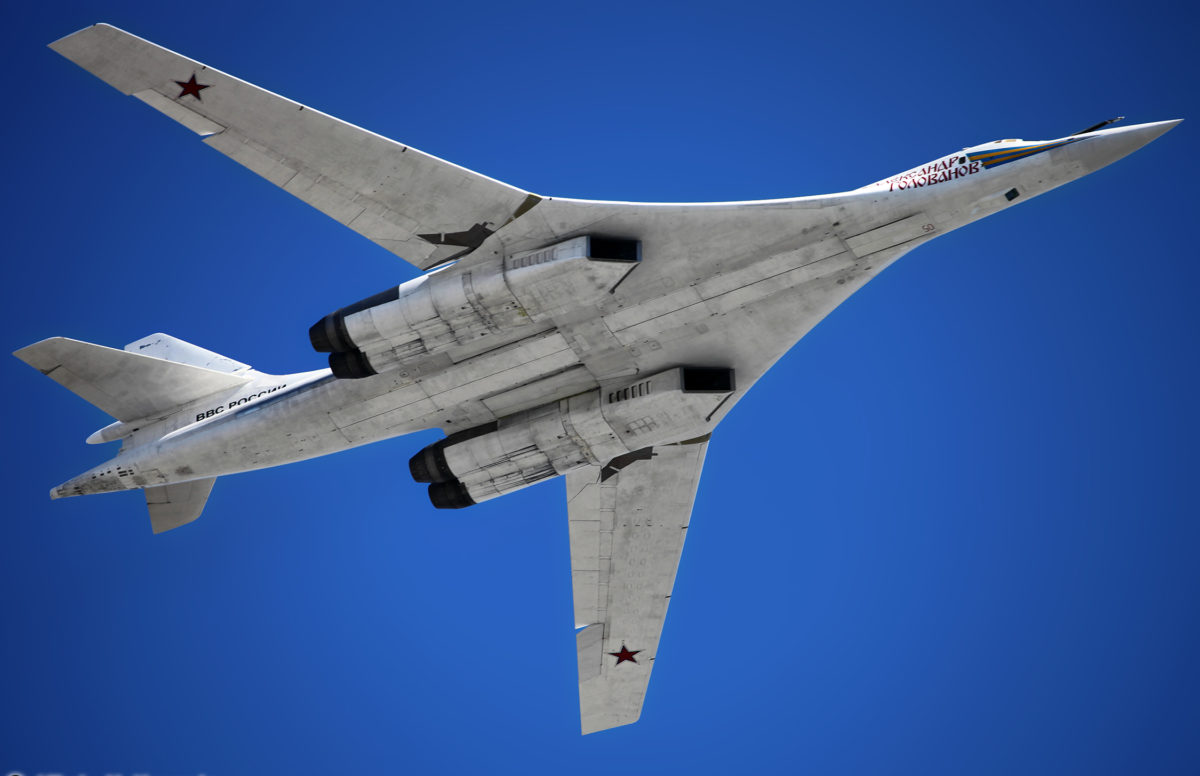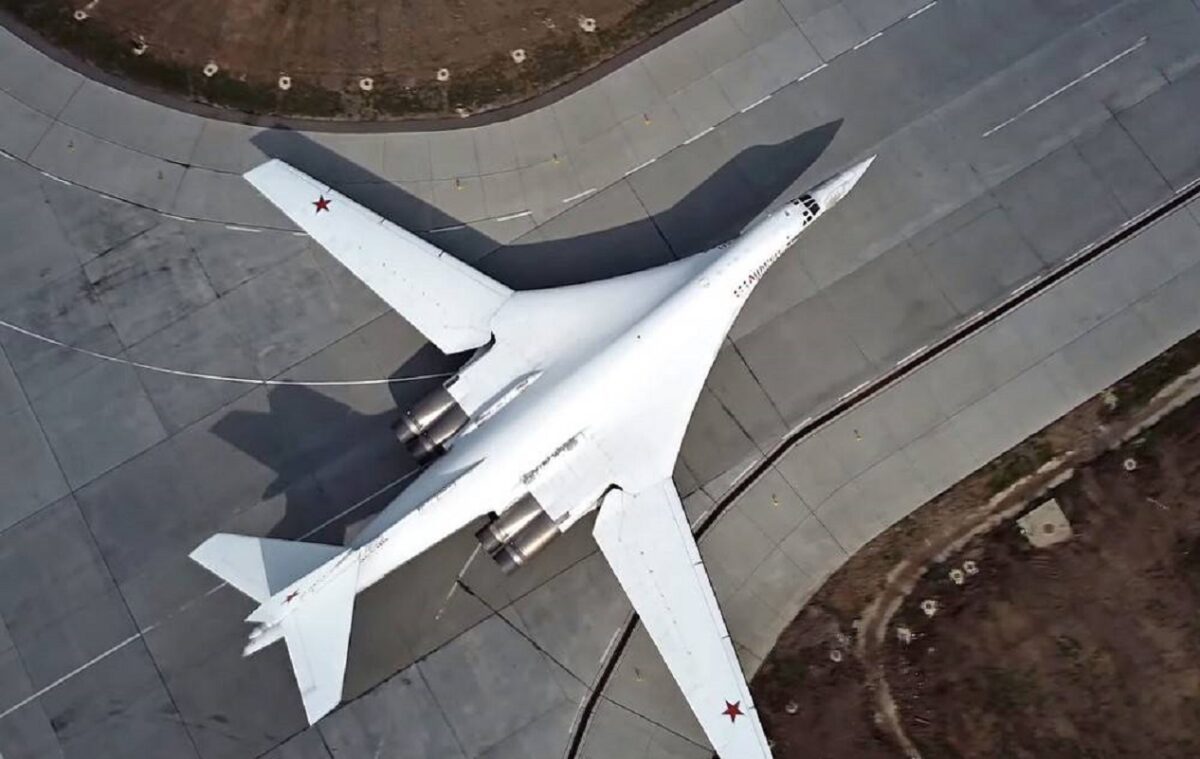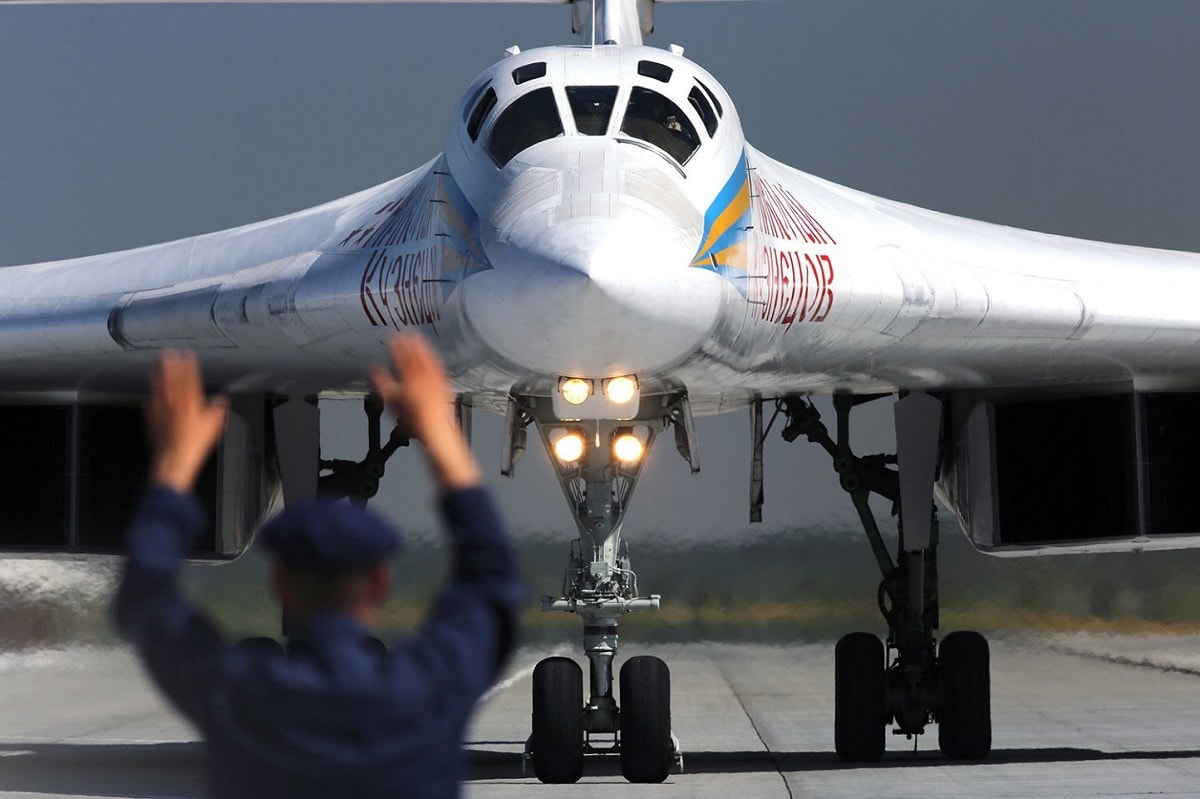Tu-160: A History – As tensions escalate between Russia and Ukraine, the latter is ironically at risk of being bombarded by aircraft and missiles it sold back to Russia 22 years ago at a bargain price.
Amongst modern military aircraft, few are as majestic yet utterly destructive in purpose as Russia’s Tupolev Tu-160 strategic bomber, dubbed the White Swan (Belyj Lebeď) and codenamed Blackjack by NATO. Capable of ranging far across the globe and unleashing a dozen nuclear weapons from standoff range, the Tu-160 remains by far the largest and fastest supersonic bomber in service. Moscow claim it will build dozens more even as China and the U.S. develop stealth bombers instead.
The Tu-160 was in its origins a reflexive product of the Cold War arms race. Though by the 1960s the Kremlin decided intercontinental ballistic missiles were more practical nuclear delivery systems than heavy bombers, it nonetheless began the development of a supersonic strategic bomber to match the U.S.’s huge, Mach 3-capable XB-70 Valkyrie.
Though the Valkyrie was canceled and replaced by the less ambitious B-1, the Soviets nonetheless tapped Tupolev to build a Soviet counter in 1972. Tupolev drafted several designs before settling in 1977 on the Project 160M design informed by the Tu-22M Backfire swing-wing supersonic bomber.
The Tu-160 made its first flight in December 1981 and entered operational service in 1987. The behemoth bomber, weighing in at 129 tons empty, mounted four extremely powerful Kuznetsov NK-32 afterburning turbojet engines—the largest on any combat aircraft!—onto an airframe with gigantic wings spanning more than half a football field (54 meters) from wingtip to wingtip.
Moreover, those massive wings could swing between three positions: fully extended at 20 degrees to maximize lift, then swept back to 35 degrees to reduce drag for subsonic cruising, and tucked fully back to 65 degrees when sprinting at the maximum speed of Mach 2.05 using afterburners. The airframe’s aerodynamically unstable characteristics were automatically compensated for by a quadruple-redundant fly-by-wire system.
The Tu-160 could carry enough fuel to fly 7,500 miles with a 50% missile payload, and its retractable refueling probe enabled even greater ranges if desired. A crew of four operates the bomber on its long-distance missions—pilot and co-pilot seated side by side in the front, and two navigators individually sub-specialized in weapons and self-defense systems.
Entering service the same year as the U.S. supersonic B-1B Lancer bomber, which it resembled in some respects, the Tu-160 was much larger and had a 70% faster maximum speed. However, the Lancer had a slighter radar signature and would evolve to employ a wider range of weapons, though it was stripped of nuclear weapons capability in the 2010s.
Though capable of conventional attacks, the Blackjack’s most important mission was, and remains, to approach close enough to North America to release up to a dozen cruise missiles each with nuclear warheads seventeen times the yield of the Fat Man bomb dropped on Hiroshima.

Tu-160 Bomber

Tu-160 Bomber. This file comes from http://vitalykuzmin.net
The most promising approach vector for the Tu-160 was via the Arctic, but that still entailed evading detection and interception by U.S. and Canadian land-based radars, interceptors and AWACS airborne early warning aircraft. And just getting there would take many hours as the Blackjack cruised at 600 miles per hour, the speed of a 747 airliner. To stave off crew burnout, Tu-160 designers thoughtfully included massage-rollers in the crew’s zero-altitude ejection seats, a galley kitchen and a toilet in the aft crew compartment.
Though Tupolev designers made some efforts to reduce Radar Cross-Section, at 10-15 square meters the Tu-160’s signature remains comparable to an F-15 fighter. Thus, Tu-160 crew would approach at low altitude to minimize detection range, using its Sopka terrain-following radar to avoid ground collision. Passive warning receivers would inform the crew once they were detected, at which point they could employ a self-defense radar jammer and light up the afterburners to surge to Mach 2 to evade interceptors.
The Tu-160’s raison d’etre were the weapons in its two 11-meter-long weapon bays: up to twelve turbofan-powered Kh-55 cruise missiles in rotary launchers with 250-kiloton warheads. Indeed, the bomber’s iconic white paint scheme is designed to reflect thermal radiation from a nuclear blast.
The Kh-55s would skim at 300 feet above the surface, navigating towards a programmed target up to 2,500 kilometers (1,553 miles) away using inertial and terrain-contour-matching navigation systems. Tu-160s could also launch the conventional-warhead Kh-555 variant, and the Kh-55SM with range extended to 3,000 kilometers (1,864 miles).

Modernized Tu-160. Image Credit: Russian Government.
Blackjacks could also be tasked with attacking U.S. carrier strike groups across the globe using an alternate payload of up to twenty-four Kh-15 air-launched ballistic missiles with a range of 186 miles. These dual nuclear/conventional-capable weapons arc high after launch before plummeting down on maritime or land targets at over five times the speed of sound, guided by either by radar or a radar-homing seeker.
There were also unrealized plans to create a Tu-161 long-range interceptor for hunting NATO maritime patrol planes, a Tu-160PP electronic warfare jet, a Tu-160R reconnaissance plane, and even Blackjacks modified to carry supersonic drones or Burlak air-launched satellite deployment vehicles.
From Soviet Union to Ukraine to Russia
Just two Tu-160s squadrons were operational when the Soviet Union collapsed in 1991—and of the 36 Tu-160s built (including several prototypes), 19 were in the 184th Guards Heavy Bomber Aviation Regiment based at Pryluky Airbase in Ukraine, and thus grandfathered into the new Ukrainian Air Force. Four more airframes remained unassembled.
The heavy bombers proved too expensive for cash-strapped Ukraine to regularly fly or even maintain. After NATO-Russia tensions flared in 1999 due to the Kosovo war, the Kremlin sought to buy Tu-160s and their missiles back from Ukraine to flesh out its own impractically small fleet. But Moscow was also short on money and couldn’t meet Kiev’s $3 billion asking price.
In the end, Russia acquired eight of the huge bombers and 575 cruise missiles from Ukraine in exchange for cancellation of $285 million in natural gas debt owed to Moscow. Ukraine scrapped the rest, save for one on display at the Poltava Museum of Heavy Bomber Aviation.
White Swan, Nuclear Troll, Syrian Scattershot
Moscow subsequently strove to rebuild its dilapidated Tu-160 force by refurbishing aircraft, and building unassembled airframes, funding permitting—though one Tu-160 and its crew were lost in a 2003 crash.
By 2021 Russia officially had 16 or 17 operational Tu-160s, though no more than 11 have been seen deployed at one time, grouped into the 121st Guards Heavy Bomber Aviation Regiment based at Engels airbase in Saratov, Russia. Most are named after famous Russian historical or fictional personages.
When Putin announced the resumption of strategic bomber patrols in 2006, the small Blackjack force and more numerous Tu-95 Bear bombers were at the forefront of Moscow’s campaign to remind everybody it could still dispatch nuclear-armed bombers to buzz by a country’s airspace. Blackjacks could tweak Washington for example with layovers in Venezuela and Nicaragua (on one occasion violating Colombian airspace) or be deployed near Alaska. Some of these patrols, aided by in-flight refueling, set new records for endurance, with Tu160s staying airborne 23 hours in 2010, and then 25 hours in 2020 while traversing over 12,400 miles.
Blackjacks were finally combat-tested in 2015, launching dozens of new Kh-101 conventional stealth cruise missiles to strikes anti-Assad insurgents in Syria in November 2015 and again in 2016. The 2015 missile attacks tended to fall wildly off-target, though it’s unknown how many misses came from Kh-101s rather than Kh-555 missiles launched by Tu-95s.
In theory, however, the Kh-101 conventional and Kh-102 nuclear missiles constitute a major upgrade, extending range to 4,000 kilometers (2,485 miles), and boasting greater stealth, re-targetability after launch and improved precision.
Second Act for the White Swan
Unlike the U.S. Air Force, which seems skeptical its B-1B bombers bring enough added value over B-52s, the Kremlin is doubling down on the Tu-160.
First of all, Russia is modernizing Tu-160s to the Tu-160M2 model, installing more fuel-efficient NK-32-02 engines expected to increase range by over 600 miles, GLONASS satellite-navigation systems, a digitized glass cockpit, and new AESA radar. It also includes the application of radar-absorbent materials to the canopy which may modestly reduce the bomber’s radar signature, new defensive countermeasures. Finally, there’s the integration of the Kh-101/102 missiles and possibly air-launched Kinzhal hypersonic weapon, giving the Tu-160 more effective and survivable weaponry.

Tu-160. Image: Creative Commons.
Russia’s Defense Ministry has also ordered production of 10 new Tu-160Ms at the Kazan factory out of an eventual planned 50 more of the Soviet-era jet bombers for 900 billion rubles, with production ostensibly to peak at three per year.
This is in part due to delays developing the PAK-DA stealth bomber. However, given the high cost of new Tu-160 production (ostensibly 16 billion rubles or $218 million per aircraft) and the arthritic state of Russian defense financing, observers are skeptical Moscow can sustain such an expensive and ambitious program, especially once the supply of unassembled or un-refurbished Tu-160 airframes is exhausted.
After all, that funds could go to the PAK-DA or more expendable stealth combat drones. However, the money and effort already devoted to the Tu-160 suggest Russia’s Blackjack fleet is likely to continue ticking upwards in the 2020s.
Still, Moscow seemingly values the conspicuous global power projection the large bomber flights provide. Moreover, attempts to renew procurement seemingly reflect faith that the White Swan and its modernized standoff-range cruise missiles have acceptable odds of penetrating U.S. air defenses, even if some Russian critics harbor doubts.
Sébastien Roblin writes on the technical, historical and political aspects of international security and conflict for publications including the 19FortyFive, The National Interest, NBC News, Forbes.com and War is Boring. He holds a Master’s degree from Georgetown University and served with the Peace Corps in China. You can follow his articles on Twitter.

